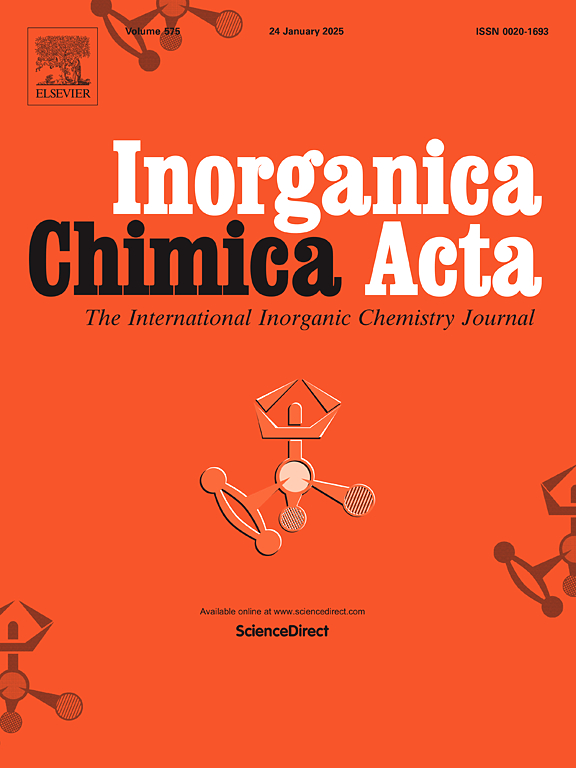Group 10 metal complexes of the 3,4-bis(dicyclohexylphosphino)thiophene (dcypt) ligand: Synthesis, characterization and catalysis
IF 2.7
3区 化学
Q2 CHEMISTRY, INORGANIC & NUCLEAR
引用次数: 0
Abstract
The nickel(II) (1), palladium(II) (2) and platinum(II) (3) complexes of the 3,4-bis(dicyclohexylphosphino)thiophene (dcypt) ligand were synthesized and characterized by multinuclear NMR and FT-IR spectroscopic techniques, mass spectrometry and elemental analysis. The nearly perfect square-planar geometry of the three complexes was confirmed by single-crystal X-ray diffraction analysis. Both complexes 1 (Ni) and 2 (Pd) were evaluated towards the Suzuki-Miyaura cross-coupling reaction between aryl halides and aryl boronic acids, a field that was not explored until now for metal complexes of dcypt. While the palladium(II) (pre)catalyst (2) was found very efficient for this transformation, both under “classical” (Cs2CO3 as base, 1,4-dioxane as solvent) and “green” (K3PO4 as base, tert-amyl alcohol (tAA) as solvent) reaction conditions, its nickel(II) analog (1) was only moderately active under the latter conditions (inactive under the former). Complex 2 was tolerant to both the presence of EDGs or EWGs groups on para position of the aryl halide or aryl boronic acid (72–99 %) and allowed the synthesis of polycyclic aromatic compounds. Moreover, the remarkable air-stability of dcypt and of its corresponding palladium(II) complex (2) allowed to perform Suzuki-Miyaura cross-coupling reactions under air and with a non-dried alcoholic solvent (tAA) without loss of activity.

3,4-双(二环己基膦)噻吩(dcypt)配体的第 10 组金属配合物:合成、表征和催化作用
本研究合成了 3,4-双(二环己基膦)噻吩(dcypt)配体的镍(II)(1)、钯(II)(2)和铂(II)(3)配合物,并通过多核核磁共振和傅立叶变换红外光谱技术、质谱分析和元素分析对其进行了表征。单晶 X 射线衍射分析证实了这三种配合物近乎完美的方形平面几何结构。络合物 1(镍)和 2(钯)都被评估用于芳基卤化物和芳基硼酸之间的 Suzukii-Miyaura 交叉偶联反应。在 "经典"(以 Cs2CO3 为碱,1,4-二氧六环为溶剂)和 "绿色"(以 K3PO4 为碱,叔戊醇 (tAA) 为溶剂)反应条件下,钯(II)(前)催化剂 (2) 对这种转化都非常有效,而其镍(II)类似物 (1) 在后一种条件下只有中等活性(在前一种条件下没有活性)。复合物 2 对芳基卤化物或芳基硼酸对位上的 EDGs 或 EWGs 基团(72-99%)都有很好的耐受性,可以合成多环芳香族化合物。此外,dcypt 及其相应的钯(II)络合物(2)具有显著的空气稳定性,可以在空气中和使用非干燥的酒精溶剂(tAA)进行 Suzukii-Miyaura 交叉偶联反应,而不会失去活性。
本文章由计算机程序翻译,如有差异,请以英文原文为准。
求助全文
约1分钟内获得全文
求助全文
来源期刊

Inorganica Chimica Acta
化学-无机化学与核化学
CiteScore
6.00
自引率
3.60%
发文量
440
审稿时长
35 days
期刊介绍:
Inorganica Chimica Acta is an established international forum for all aspects of advanced Inorganic Chemistry. Original papers of high scientific level and interest are published in the form of Articles and Reviews.
Topics covered include:
• chemistry of the main group elements and the d- and f-block metals, including the synthesis, characterization and reactivity of coordination, organometallic, biomimetic, supramolecular coordination compounds, including associated computational studies;
• synthesis, physico-chemical properties, applications of molecule-based nano-scaled clusters and nanomaterials designed using the principles of coordination chemistry, as well as coordination polymers (CPs), metal-organic frameworks (MOFs), metal-organic polyhedra (MPOs);
• reaction mechanisms and physico-chemical investigations computational studies of metalloenzymes and their models;
• applications of inorganic compounds, metallodrugs and molecule-based materials.
Papers composed primarily of structural reports will typically not be considered for publication.
 求助内容:
求助内容: 应助结果提醒方式:
应助结果提醒方式:


